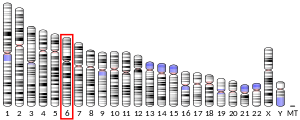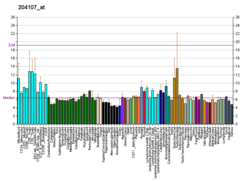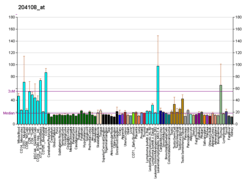NFYA
Nuclear transcription factor Y subunit alpha is a protein that in humans is encoded by the NFYA gene.[5][6]
Function
The protein encoded by this gene is one subunit of a trimeric complex NF-Y, forming a highly conserved transcription factor that binds to CCAAT motifs in the promoter regions in a variety of genes.[7] Subunit NFYA associates with a tight dimer composed of the NFYB and NFYC subunits, resulting in a trimer that binds to DNA with high specificity and affinity. The sequence specific interactions of the complex are made by the NFYA subunit, suggesting a role as the regulatory subunit. In addition, there is evidence of post-transcriptional regulation in this gene product, either by protein degradation or control of translation. Further regulation is represented by alternative splicing in the glutamine-rich activation domain, with clear tissue-specific preferences for the two isoforms.[8]
NF-Y complex serves as a pioneer factor by promoting chromatin accessibility to facilitate other co-localizing cell type-specific transcription factors.[9]
NF-Y has also been implicated as a central player in transcription start site (TSS) selection in animals.[10] It safeguards the integrity of the nucleosome-depleted region and PIC localization at protein-coding gene promoters.
Interactions
NFYA has been shown to interact with Serum response factor[11] and ZHX1.[11][12] NFYA, NFYB and NFYC form the NFY complex and it has been shown that the NFY complex serves as a pioneer factor by promoting chromatin accessibility to facilitate other co-localizing cell type-specific transcription factors.[7]
References
- GRCh38: Ensembl release 89: ENSG00000001167 - Ensembl, May 2017
- GRCm38: Ensembl release 89: ENSMUSG00000023994 - Ensembl, May 2017
- "Human PubMed Reference:". National Center for Biotechnology Information, U.S. National Library of Medicine.
- "Mouse PubMed Reference:". National Center for Biotechnology Information, U.S. National Library of Medicine.
- Li XY, Mattei MG, Zaleska-Rutczynska Z, Hooft van Huijsduijnen R, Figueroa F, Nadeau J, Benoist C, Mathis D (November 1991). "One subunit of the transcription factor NF-Y maps close to the major histocompatibility complex in murine and human chromosomes". Genomics. 11 (3): 630–4. doi:10.1016/0888-7543(91)90070-U. PMID 1774067.
- Maity SN, de Crombrugghe B (May 1998). "Role of the CCAAT-binding protein CBF/NF-Y in transcription". Trends in Biochemical Sciences. 23 (5): 174–8. doi:10.1016/S0968-0004(98)01201-8. PMID 9612081.
- Oldfield AJ, Yang P, Conway AE, Cinghu S, Freudenberg JM, Yellaboina S, Jothi R (September 2014). "Histone-fold domain protein NF-Y promotes chromatin accessibility for cell type-specific master transcription factors". Molecular Cell. 55 (5): 708–22. doi:10.1016/j.molcel.2014.07.005. PMC 4157648. PMID 25132174.
- "Entrez Gene: NFYA nuclear transcription factor Y, alpha".
- Oldfield AJ, Yang P, Conway AE, Cinghu S, Freudenberg JM, Yellaboina S, Jothi R (September 2014). "Histone-fold domain protein NF-Y promotes chromatin accessibility for cell type-specific master transcription factors". Molecular Cell. 55 (5): 708–22. doi:10.1016/j.molcel.2014.07.005. PMC 4157648. PMID 25132174.
- Oldfield AJ, Henriques T, Burkholder AB, Paulet D, Cinghu S, Yang P, Scruggs BS, Lavender CA, Kumar D, Bennett B, Rivals E (11 July 2019). "NF-Y controls fidelity of transcription initiation at gene promoters through maintenance of the nucleosome-depleted region". Nature Communications. 10 (1): 3072. doi:10.1038/s41467-019-10905-7. PMC 6624317. PMID 31296853.
- Yamada K, Osawa H, Granner DK (October 1999). "Identification of proteins that interact with NF-YA". FEBS Letters. 460 (1): 41–5. doi:10.1016/S0014-5793(99)01311-3. PMID 10571058.
- Yamada K, Printz RL, Osawa H, Granner DK (August 1999). "Human ZHX1: cloning, chromosomal location, and interaction with transcription factor NF-Y". Biochemical and Biophysical Research Communications. 261 (3): 614–21. doi:10.1006/bbrc.1999.1087. PMID 10441475.
Further reading
- Mantovani R (October 1999). "The molecular biology of the CCAAT-binding factor NF-Y". Gene. 239 (1): 15–27. doi:10.1016/S0378-1119(99)00368-6. PMID 10571030.
- Li XY, Mantovani R, Hooft van Huijsduijnen R, Andre I, Benoist C, Mathis D (March 1992). "Evolutionary variation of the CCAAT-binding transcription factor NF-Y". Nucleic Acids Research. 20 (5): 1087–91. doi:10.1093/nar/20.5.1087. PMC 312095. PMID 1549471.
- Li XY, Hooft van Huijsduijnen R, Mantovani R, Benoist C, Mathis D (May 1992). "Intron-exon organization of the NF-Y genes. Tissue-specific splicing modifies an activation domain". The Journal of Biological Chemistry. 267 (13): 8984–90. PMID 1577736.
- Becker DM, Fikes JD, Guarente L (March 1991). "A cDNA encoding a human CCAAT-binding protein cloned by functional complementation in yeast". Proceedings of the National Academy of Sciences of the United States of America. 88 (5): 1968–72. doi:10.1073/pnas.88.5.1968. PMC 51147. PMID 2000400.
- Vuorio T, Maity SN, de Crombrugghe B (December 1990). "Purification and molecular cloning of the "A" chain of a rat heteromeric CCAAT-binding protein. Sequence identity with the yeast HAP3 transcription factor". The Journal of Biological Chemistry. 265 (36): 22480–6. PMID 2266139.
- Mantovani R, Li XY, Pessara U, Hooft van Huisjduijnen R, Benoist C, Mathis D (August 1994). "Dominant negative analogs of NF-YA". The Journal of Biological Chemistry. 269 (32): 20340–6. PMID 8051128.
- Currie RA (December 1997). "Functional interaction between the DNA binding subunit trimerization domain of NF-Y and the high mobility group protein HMG-I(Y)". The Journal of Biological Chemistry. 272 (49): 30880–8. doi:10.1074/jbc.272.49.30880. PMID 9388234.
- Currie RA (July 1998). "Biochemical characterization of the NF-Y transcription factor complex during B lymphocyte development". The Journal of Biological Chemistry. 273 (29): 18220–9. doi:10.1074/jbc.273.29.18220. PMID 9660784.
- Roder K, Wolf SS, Larkin KJ, Schweizer M (June 1999). "Interaction between the two ubiquitously expressed transcription factors NF-Y and Sp1". Gene. 234 (1): 61–9. doi:10.1016/S0378-1119(99)00180-8. PMID 10393239.
- Yamada K, Printz RL, Osawa H, Granner DK (August 1999). "Human ZHX1: cloning, chromosomal location, and interaction with transcription factor NF-Y". Biochemical and Biophysical Research Communications. 261 (3): 614–21. doi:10.1006/bbrc.1999.1087. PMID 10441475.
- Yamada K, Osawa H, Granner DK (October 1999). "Identification of proteins that interact with NF-YA". FEBS Letters. 460 (1): 41–5. doi:10.1016/S0014-5793(99)01311-3. PMID 10571058.
- Fan W, Jin S, Tong T, Zhao H, Fan F, Antinore MJ, Rajasekaran B, Wu M, Zhan Q (March 2002). "BRCA1 regulates GADD45 through its interactions with the OCT-1 and CAAT motifs". The Journal of Biological Chemistry. 277 (10): 8061–7. doi:10.1074/jbc.M110225200. PMID 11777930.
- Faniello MC, Chirico G, Quaresima B, Cuda G, Allevato G, Bevilacqua MA, Baudi F, Colantuoni V, Cimino F, Venuta S, Avvedimento VE, Costanzo F (April 2002). "An alternative model of H ferritin promoter transactivation by c-Jun". The Biochemical Journal. 363 (Pt 1): 53–8. doi:10.1042/0264-6021:3630053. PMC 1222450. PMID 11903046.
- Bevilacqua MA, Faniello MC, Iovine B, Russo T, Cimino F, Costanzo F (November 2002). "Transcription factor NF-Y regulates differentiation of CaCo-2 cells". Archives of Biochemistry and Biophysics. 407 (1): 39–44. doi:10.1016/S0003-9861(02)00436-8. PMID 12392713.
- Ge Y, Jensen TL, Matherly LH, Taub JW (December 2002). "Synergistic regulation of human cystathionine-beta-synthase-1b promoter by transcription factors NF-YA isoforms and Sp1". Biochimica et Biophysica Acta (BBA) - Gene Structure and Expression. 1579 (2–3): 73–80. doi:10.1016/s0167-4781(02)00509-2. PMID 12427542.
- Salsi V, Caretti G, Wasner M, Reinhard W, Haugwitz U, Engeland K, Mantovani R (February 2003). "Interactions between p300 and multiple NF-Y trimers govern cyclin B2 promoter function". The Journal of Biological Chemistry. 278 (9): 6642–50. doi:10.1074/jbc.M210065200. PMID 12482752.
- Peng Y, Jahroudi N (March 2003). "The NFY transcription factor inhibits von Willebrand factor promoter activation in non-endothelial cells through recruitment of histone deacetylases". The Journal of Biological Chemistry. 278 (10): 8385–94. doi:10.1074/jbc.M213156200. PMID 12511565.
External links
- NFYA+protein,+human at the US National Library of Medicine Medical Subject Headings (MeSH)
- FactorBook NF-YA
This article incorporates text from the United States National Library of Medicine, which is in the public domain.






